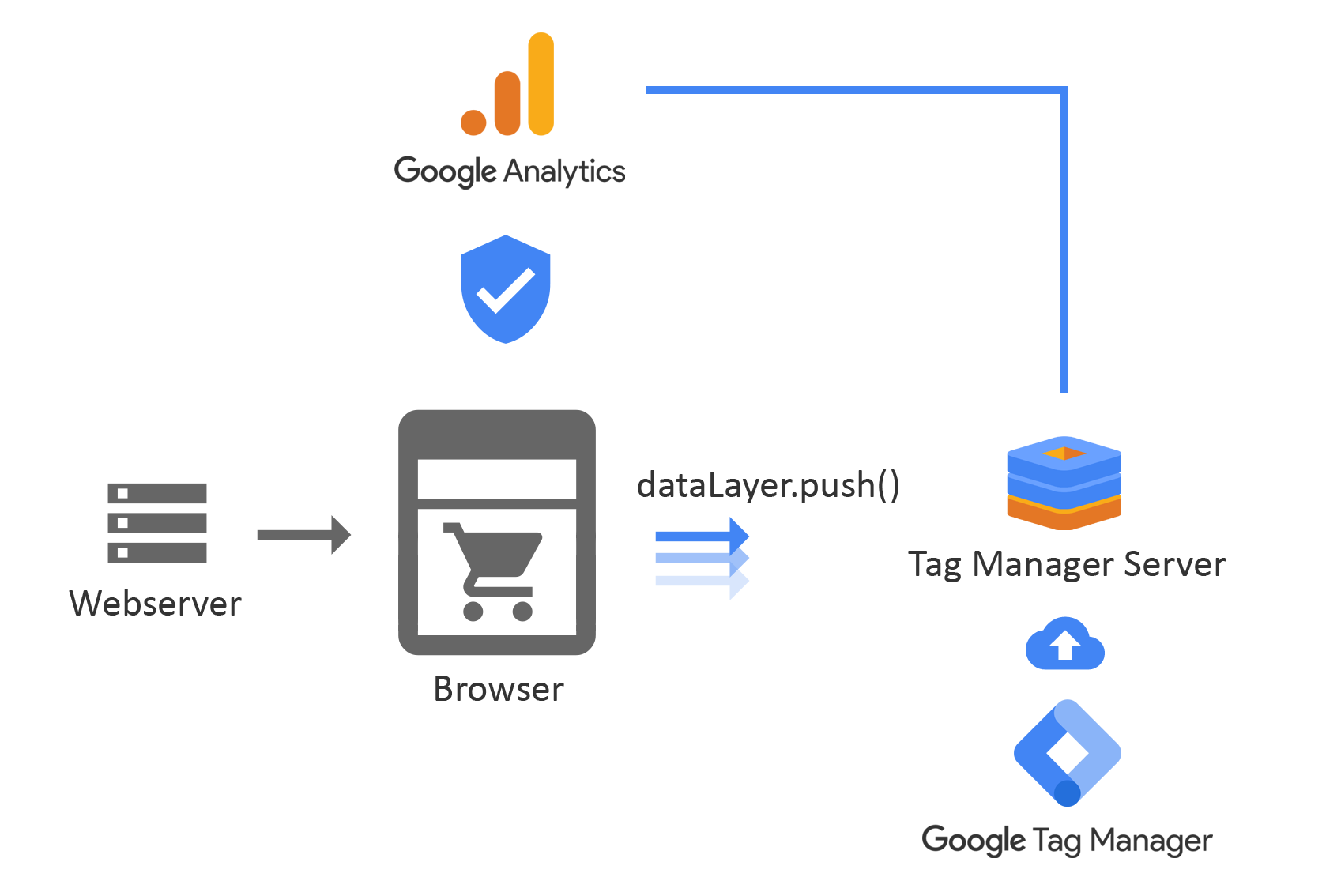
Client-Side and Server-Side Tracking to Understand Customers Better
Last update: 4 June 2024 at 03:23 pm
There are two ways of collecting data and delivering it: Client-side and server-side approaches.
- Client-side is the most common approach where the application sends data to the server, which then processes it.
- Server-side tracking is a more complicated approach where the web server generates its customer data, which gets sent back to the client.
The Client-side is easy to implement but has certain drawbacks, such as having a single point of failure. Server-side tracking has its disadvantages, such as not being able to scale up or down easily and being difficult for developers to maintain.
Define Client-Side Tracking
The client-side data delivery is accomplished with the help of a tag management system. This is one of the best ways to transmit data from web pages.
Nowadays, more people are using tags for client-side delivery of data, which is accomplished through tags inserted into the HTML code of a web page.
Tag management systems can be created by developers or by site owners themselves. The amount of tags that exist is huge, and it’s difficult for site owners to know which ones they should use and when they should use them. This is where tag management comes into the picture. Some also choose a Google Tag Manager to help with tracking data.

Define Server Side Tracking
Server-side data management was first introduced in the late 1990s and became popular in the 2000s. Server-side delivery is not a new technology, but it has gained more traction as more companies opt for it.
It allows companies to save on bandwidth and storage costs, which is important for businesses that rely on digital marketing.
Server-side delivery also provides better security because the user’s personal information is sent directly to the company’s servers instead of being sent to a third-party web server.
What Does It Mean to Be Side-Tracked?
Side-tracking is a term that refers to the loss of customer data that occurs when a customer goes off-track and leaves your website without completing their purchase.
Companies track customers using cookies and unique identifiers tied to an individual’s account. These identifiers can be found on their shopping cart, on their email address, or their credit card billing address, the billing address of their credit card. If you’re tracking these identifiers, you may see what other products they have purchased from your company in the past.
Side-tracking generally happens when customers change their minds about a purchase or leave your website without completing it.

There are many different causes for side-tracking, and it tends to happen most often with e-commerce websites as they have more opportunities for customers to leave when they’re
Sifting through mounds of data can be confusing and overwhelming for any company. You may want to hire the services of a data consulting agency to give you some clarity.
What Is Another Word for Side Tracking?
The phasing out of third-party cookies is a big step in the right direction for privacy. However, tracking the client-side will become difficult with this phasing out.
There are several ways to implement client-side tracking without using third-party cookies. One way is to use a google chrome browser extension to track users without them knowing it. Another option is to use a server-side script that sends data back to the client-side script, then sends the data back to your server to be aggregated and analyzed.
What Does Web Server Side Tracking Mean?
Server-side tracking means that the website or app runs tags to it on a computer, not a device. This means that the data is stored and processed on the webserver instead of the client’s device (related: read more about what is server-side tagging).
Server-side tracking helps to improve the security and performance of websites and apps by reducing bandwidth usage and enabling users to get direct access to content in real-time. It also helps to reduce load time as well as lower maintenance costs.
Is It Side Tract or Side-Tracked?
The correct term is side-tracked. Client-side and server-side are the two ways to deliver data and data collection. The client-side is the first point of interaction with the user, which means it’s where we see all of our website’s content. The server-side is where data is stored and made available for other users.
When Is the Right Time to Track on Client and Server?
The best time to start tracking on client and server is when you have a clear understanding of the goals. If you know that you need to track on a specific time, then it’s best to start tracking when your project starts. However, if you don’t know your goals, it’s best to start with a smaller goal and work your way up.
The right time to track on client and server is when a user interaction occurs. This could be anything from a click, hover, or scroll event that you want to track. The goal is to identify the user’s path through your site and know what they did while they were there.
If you’re using Google web Analytics, you can set up the event tracking in Google Analytics settings under the Event Tracking section. Implementing analytics from Google will work in your favor.
Client Side Tracking Advantages
Contextual Data
Client-side tracking tracks user behavior on their device, giving access to user-specific data. Client-side tracking takes place on the user’s mobile device. It gives access to data that is user-specific. This makes it easier for marketers and publishers to engage with users and understand what they need.
The best example of client-side tracking is Google Analytics. It allows marketers and publishers to easily track users across the user’s device and see how users interact with their content.
Implementation Ease
Client-side tracking is easy to install. This is because there are no additional costs required, unlike server-side tracking. In addition, this type of tracker does not require any technical knowledge and can be installed with a few clicks of a button on the website.
This is because client-side tracking takes up less space on your website most of the time than a traditional analytics tool. This makes it easier for you to manage data and optimize your website rather than worrying about how much space you’re going to need on your server.
Lower Cost
Client-side tracking is a type of online marketing that involves data being sent directly from the website visitor’s computer to the company’s servers and then onto the company’s website. Some companies prefer this method because it is cheaper than server-side tracking.
The costs for client-side tracking and data transmission are usually lower than server-side tracking. This is because the data does not need to be processed or stored before it reaches its destination, which saves on time and money.
Server-Side Tracking Advantages
Accuracy & Reliability
Client-side tracking involves millions of scenarios and devices. While these tracking solutions can be difficult to implement, they are becoming more popular with companies.
One of the most complex tasks for a company to handle is tracking their customer’s activity online. While these solutions are not always easy to implement, they do provide many benefits for companies that choose to use them.
The implementations of these solutions vary from company to company, and there are many different options for this type of solution.
Performance of Application and Device
Server-side tracking removes the burden of processing from a client’s device and then moves it to the cloud. Server-side tracking is an effective way to track users across multiple devices. This is because it doesn’t rely on cookies or browser fingerprinting, which users can easily block.
This technology is especially useful for companies with large amounts of data and data collection needed in bulk. Server-side tracking also has the advantage of keeping user data private because it isn’t stored on a device but rather on a server.
Unlock the Benefit of Client/Server Tracking Optimization
The data foundation is the steering wheel of a data-driven business. It sets the direction for all other decisions and drives the business forward.
The first step in establishing a modular and vendor-neutral data foundation is establishing a clear purpose for your data.
To establish a modular and vendor-neutral data foundation, you need to know what you need your data for, how it will be used, who will use it, and how often it will be used. It is not easy to track and deliver data on either the server or client-side.
Conclusion
The term “cloud” has become a popular way to describe the internet. It is most often used to describe a service delivered to the user agent through software applications and over the internet, such as Google Drive or Dropbox.
While companies may use cloud-based services for data collection and delivery, not every situation can deliver server-side tracking.
Some situations require the data to be delivered to a specific device or location. This can be done via a client-side app that uses the device’s data connection or an internet browser with a local storage option.
Choosing the right solution depends on your goals and capabilities. Data management practices are changing rapidly, and organizations need to be flexible in terms of capabilities that accommodate traditional and emerging data management practices.
In the past, companies could use the same methods for managing data across their business units. However, with the emergence of different types of data, such as structured, unstructured, and semi-structured, it’s essential to have a flexible capability to accommodate these different types of data and get the best data quality.





